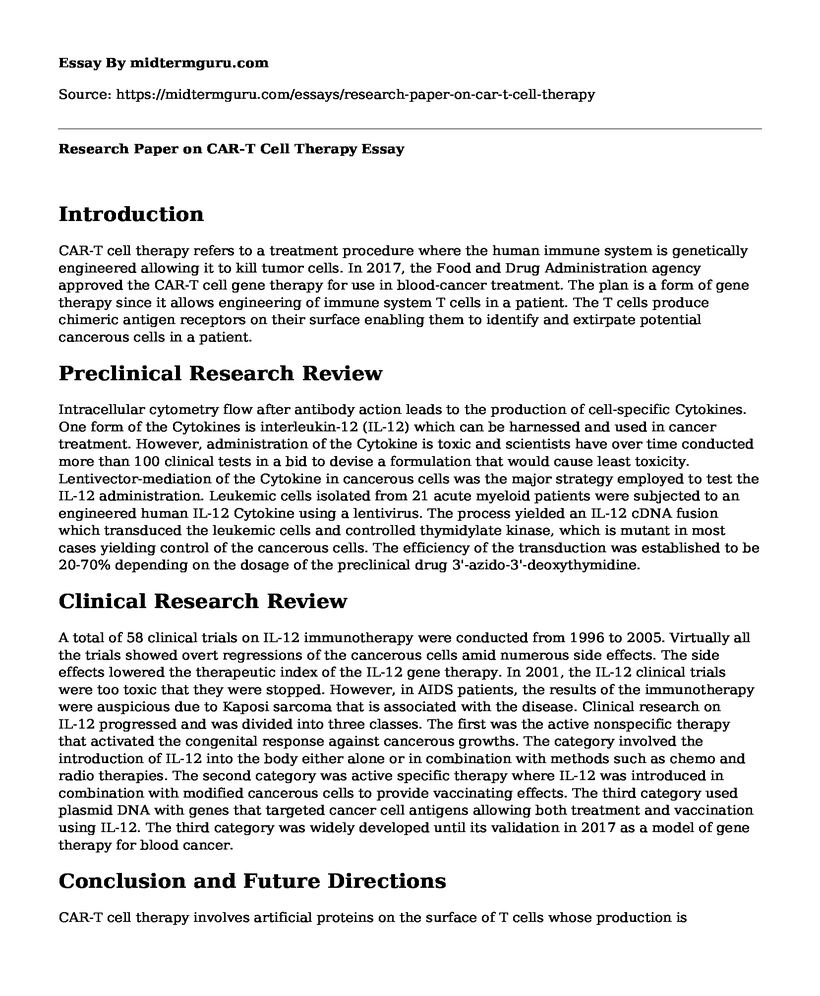Introduction
CAR-T cell therapy refers to a treatment procedure where the human immune system is genetically engineered allowing it to kill tumor cells. In 2017, the Food and Drug Administration agency approved the CAR-T cell gene therapy for use in blood-cancer treatment. The plan is a form of gene therapy since it allows engineering of immune system T cells in a patient. The T cells produce chimeric antigen receptors on their surface enabling them to identify and extirpate potential cancerous cells in a patient.
Preclinical Research Review
Intracellular cytometry flow after antibody action leads to the production of cell-specific Cytokines. One form of the Cytokines is interleukin-12 (IL-12) which can be harnessed and used in cancer treatment. However, administration of the Cytokine is toxic and scientists have over time conducted more than 100 clinical tests in a bid to devise a formulation that would cause least toxicity. Lentivector-mediation of the Cytokine in cancerous cells was the major strategy employed to test the IL-12 administration. Leukemic cells isolated from 21 acute myeloid patients were subjected to an engineered human IL-12 Cytokine using a lentivirus. The process yielded an IL-12 cDNA fusion which transduced the leukemic cells and controlled thymidylate kinase, which is mutant in most cases yielding control of the cancerous cells. The efficiency of the transduction was established to be 20-70% depending on the dosage of the preclinical drug 3'-azido-3'-deoxythymidine.
Clinical Research Review
A total of 58 clinical trials on IL-12 immunotherapy were conducted from 1996 to 2005. Virtually all the trials showed overt regressions of the cancerous cells amid numerous side effects. The side effects lowered the therapeutic index of the IL-12 gene therapy. In 2001, the IL-12 clinical trials were too toxic that they were stopped. However, in AIDS patients, the results of the immunotherapy were auspicious due to Kaposi sarcoma that is associated with the disease. Clinical research on IL-12 progressed and was divided into three classes. The first was the active nonspecific therapy that activated the congenital response against cancerous growths. The category involved the introduction of IL-12 into the body either alone or in combination with methods such as chemo and radio therapies. The second category was active specific therapy where IL-12 was introduced in combination with modified cancerous cells to provide vaccinating effects. The third category used plasmid DNA with genes that targeted cancer cell antigens allowing both treatment and vaccination using IL-12. The third category was widely developed until its validation in 2017 as a model of gene therapy for blood cancer.
Conclusion and Future Directions
CAR-T cell therapy involves artificial proteins on the surface of T cells whose production is genetically induced. T cells have the purpose of protecting the body against foreign organisms, but cannot inhibit cancerous growths in their innate states. Gene therapy allows production of chimeric antigen receptors on the cell surfaces allowing identification and killing of cancerous cells. The Memorial Sloan Kettering Cancer Centre conducted a trial on CAR-T cell gene therapy with 63 patients. 83 percent of the patients experienced cancer remission in less than 3 months. Therefore, CAR-T therapy is of particularly great importance to cancer patients whose bodies fail to respond to other conventional cancer treatment procedures. Researchers should work on ways to make CAR-T cell therapy usable in other types of cancers. At present, the engineered T cells are only useable in blood cancer since cellular masses entrap them. Also, CAR-T cell therapy should have its cost subsidized and be approved as a first option treatment procedure for leukemia. This is because the 2017 approval only allowed its use after failure of other treatment methods.
Cite this page
Research Paper on CAR-T Cell Therapy. (2022, Sep 07). Retrieved from https://midtermguru.com/essays/research-paper-on-car-t-cell-therapy
If you are the original author of this essay and no longer wish to have it published on the midtermguru.com website, please click below to request its removal:
- Nursing Essay Sample: The Environmental Theory
- Paper Example on HIV/AIDS: In Search of a Cure
- Essay Sample on Breast Cancer and Prostate Cancer Disorders
- Essay Sample on Systemic Lupus Erythematous
- Evaluation Essay on Bill Wilson Center
- Cancer: Diagnosis, Treatment, and Debate - Research Paper
- Alternative Medicine: Exploring Options Beyond Standard Care - Essay Sample







